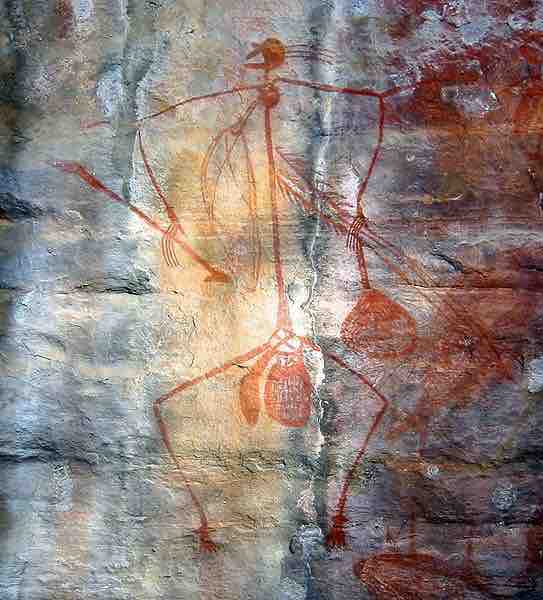Aboriginal and Indigenous Art
The visual arts have a long history in Australia, from ancient Aboriginal rock paintings to colonial landscapes to contemporary movements of today. Aboriginal art in Australia can be traced back at least 30,000 years; the rock art of Australian Aborigines is one of the longest continuously practiced artistic traditions in the world.
Rock paintings are divided into three periods based on the styles and content of the art: the Pre-Estuarine Period (c. 40,000–6000 BCE), the Estuarine Period (c. 6000 BCE–500 CE), and the Fresh Water Period (c. 500 CE–present). There are also three regional styles of cave art:
- The geometric style (known for its concentric circles, arcs, and dots) found in Central Australia, Tasmania, the Kimberly, and Victoria;
- The simple figurative style found in Queensland; and
- The complex figurative style found in Arnhem Land.
Rock paintings are believed to have served several functions, from ceremonial to merely decorative. Today, they are preserved in national parks throughout the continent and protected through organizations such as the Friends of Australian Rock Art.

Aboriginal Rock Art, Ubirr Art Site, Kakadu National Park, Australia
Aboriginal art in Australia can be traced back at least 30,000 years.
Influence of Aboriginal Art Today
The influence of Aboriginal artwork in Australia carries over to the 19th and 20th centuries in the works of William Barak, who recorded traditional aboriginal ways for the education of Westerners; Margaret Preston, a non-indigenous painter incorporating Aboriginal influences in her works; Albert Namatjira, an Arrernte artists whose landscapes inspired the Hermannsburg School of art; and Elizabeth Durack, notable for her fusion of Western and indigenous influences.
In 1971, Geoffrey Bardon encouraged the Aboriginal people of Papunya to paint their Dreamtime stories about creation, people, animals, and customs on canvas. This led to the development of the Papunya Tulaschool, or dot art, now possibly Australia's most recognizable style of art worldwide. Clifford Possum Tjapaltjarri, Long Jack Phillipus Tjakamarra, and William Sandy are some of the best known Papunya artists. Other Aboriginal artists have incorporated western mediums into their work, such as Emily Kngwarreye, Rover Thomas and Freddy Timms.